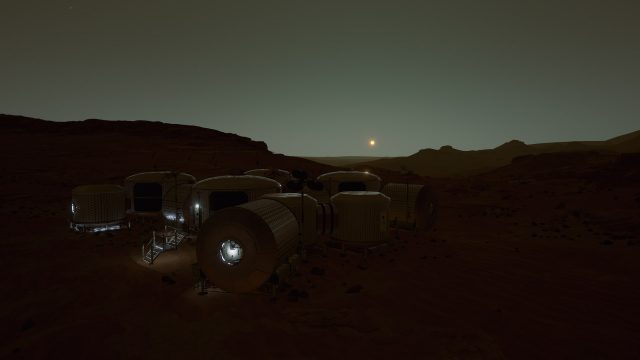What I’m getting to is this: after hours of testing Mars 2030, I’m still struggling to figure out what is the best way to experience it. It certainly feels like an experience developed with gamepad in mind, but without an obvious camera reset button, it’s practically impossible to use the gamepad when on foot. There’s no obvious solution to the issue of wanting to sit and stand each time you get in and out of the rover, but again, it really needs a quick-access camera reset. Bizarrely, turning with the right stick on a gamepad rotates the avatar body (and HUD), but not the head, another body Presence issue. I’d rather use a gamepad to control the rover, but much rather use motion controllers to pick up rocks. Frankly, the most consistent, least problematic way to play has been on a monitor with a mouse and keyboard. Interestingly, I also felt a small degree of nausea playing it on a monitor too. I’ve played countless first-person games on a monitor without issue; the only other example that caused nausea was The Witness, a possible combination of unusual rotation and movement acceleration, no FOV adjustment, and a lack of crosshair (which was quickly fixed).

Mars 2030 feels unfinished. The menu system is partly broken; not only are the controller maps missing, but the graphics settings don’t seem to register, and it struggles with save slots and checkpoints. The main objective, which involves finding interesting rocks to assess in the Geolab under a microscope, was impossible to finish, as the game would always forget my ‘geolab progress’ each time it crashed, not recognising that I had found samples. Unless more missions unlock after all the Geolab samples are found, it feels like there simply isn’t enough to do, but developer FMG Labs say there could be additional missions in the future.

Despite its bugs, Mars 2030 is capable of delivering a remarkably atmospheric experience. Its audio deserves particular mention, with convincing, ambisonic sound effects and a suitably grand musical score performed by the London Symphonic Orchestra. The horn melody that plays out each time you place a flag is magnificent. The voice acting is mediocre, but it is welcome, and educational. The accelerated day-night cycle is spectacular, with shadows casting realistically across the landscape. The distinctive blue sunsets and sunrises have an eerie, magical quality, and the blackness of night is mildly terrifying in a VR headset. If you’re looking for a powerful sense of isolation, this might be the one. The software is at its best when you stand still, stop fighting the controls and simply take in the view.
– – — – –
Mars 2030 is launching soon on Steam for HTC Vive and Oculus Rift on July 27th and comes to PSVR later this summer. It will cost $15 and will be free for students and educators, as part of the NASA Space Act Agreement.






